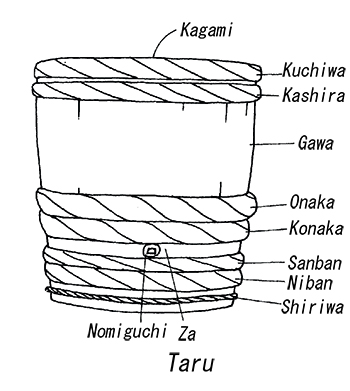Taru
- 【English】
- Barrel , cask
- 【Japanese】
- 樽
The Japanese words taru (樽) and oke (桶), refer to similar vessels, but taru have fixed lids, and were used in the sake industry as containers for sake to be sold or transported. As the sake industry grew, cooperage became more specialized, eventually becoming an independent industry.
Taru are made of Japanese cedar boards assembled in a cylindrical shape and bound with hoops of woven bamboo (called taga (輪)), with the base and the lid fixed. This form is known as yui-daru (縛樽). They come in standard 72l, 36l and 18l sizes, known respectively as yon-to daru (四斗樽, “four-to cask” or oo-daru, 大樽, large cask), han-daru (半樽, “half-cask”) and to-daru (斗樽; one to is 18l). Taru holding 1.8l also exist.
Aside from the conventional yui-daru form already mentioned, such forms as sashi-daru (指樽), hira-daru (遍樽), yanagi-daru (柳樽) and tsuno-daru (角樽) exist, but these are now only used in special cases.
The parts of the taru are as given from the top in the diagram below.
Kagami (鏡). The board making up the lid. It has a hole for filling sake, and the wooden plug for this hole is called a tenboshi (天星). By striking the lid while filling, it is possible to tell how much sake is inside, and this also has the effect of getting rid of bubbles inside. The wooden mallet finally used to close the hole by striking the tenboshi bung is called a banjo (long “o”).
Kuchiwa (口輪). Top hoop.
Kashira (頭). Second hoop.
Gawa (側). This is the boards making up the the side portion.
Onaka (long “o”) (大中). Large middle hoop.
Konaka (小中). Small middle hoop.
Nomiguchi (吞口). This is the hole for drawing off sake.
Za (座).
Sanban (三番). “Third hoop” (counted from the bottom).
Niban (二番). “Second hoop” (counted from the bottom).
Shiriwa (尻輪). Bottom hoop.
There are seven kinds of bamboo hoops, as named above, but the konaka ring is omitted for the 18l taru.


